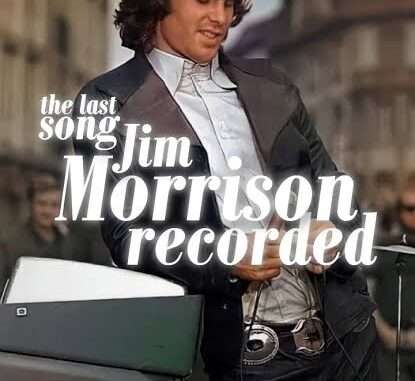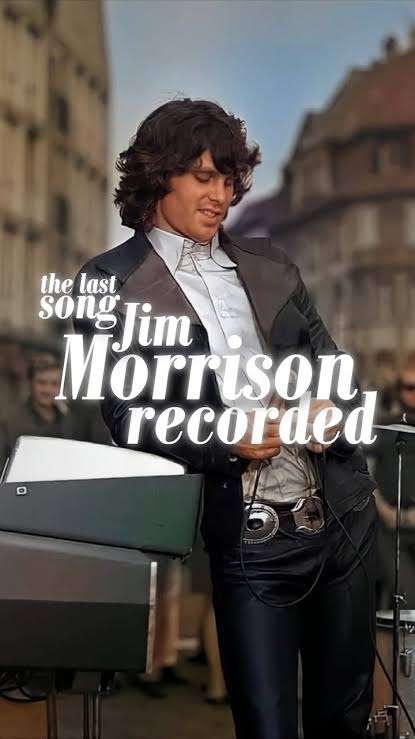
When Jim Morrison stepped into the recording booth in early 1971 to record “**Riders on the Storm**,” he likely didn’t realize it would be the last time his voice would ever echo through a studio microphone. The haunting track — the closing song on **The Doors’** final album with Morrison, *L.A. Woman* — stands today as both an artistic masterpiece and an eerie farewell from one of rock’s most enigmatic figures.
The Birth of a Dark Western Dream
“Riders on the Storm” was conceived during a jam session inspired by the country classic “(Ghost) Riders in the Sky.” Guitarist **Robby Krieger** began playing a riff that evoked the sound of galloping horses under storm clouds, while **Ray Manzarek** layered in ghostly Fender Rhodes keyboard lines that mimicked the rhythm of falling rain.
As the storm rolled in musically, Morrison added the finishing touch — a set of lyrics that transformed the jam into something otherworldly. His words painted a cinematic scene of a mysterious hitchhiker, a desolate highway, and the ever-present storm that seemed to follow him everywhere.
The song’s imagery captured the essence of The Doors’ music: part poetry, part menace, and wholly hypnotic. “Riders on the Storm” was a journey into the unknown — much like Morrison’s own life at that point.
Morrison’s Last Recording Session
By the time the *L.A. Woman* sessions began in late 1970, The Doors were in transition. They had parted ways with their longtime producer **Paul A. Rothchild**, who dismissed the new material as “cocktail music,” prompting the band to self-produce the record with engineer **Bruce Botnick**. The sessions took place in their own rehearsal space at 8512 Santa Monica Boulevard — a more relaxed environment where Morrison could roam freely between the microphone, the sofa, and the liquor cabinet.
During those sessions, Morrison was visibly tired. Years of heavy drinking, legal battles, and public scandals had taken their toll. Yet when he sang, the old fire still burned bright. For “Riders on the Storm,” he delivered one of his most controlled and emotional performances.
The magic came with a final creative twist: Morrison recorded a **whispered vocal track** beneath his main take, murmuring the same lines almost like a ghost haunting his own song. That ethereal echo, drifting under his lead vocal, created a chilling effect unlike anything else in rock at the time.
That whispered overdub would become **the last vocal recording Jim Morrison ever made**.
A Haunting Farewell
Released in June 1971, *L.A. Woman* became both a critical and commercial success, returning The Doors to their blues-rock roots while capturing a sense of impending finality. “Riders on the Storm,” the album’s closing track, stood apart — a somber, rain-soaked meditation on fate and mortality.
Just weeks after its release, Morrison left Los Angeles for Paris with his longtime companion **Pamela Courson**, hoping to find peace and focus on writing poetry. He would never return. On July 3, 1971, he was found dead in the bathtub of his apartment at 17 Rue Beautreillis. He was 27 years old.
Listening to “Riders on the Storm” today, it’s impossible not to hear it as a self-written eulogy. The lyrics — “There’s a killer on the road / His brain is squirming like a toad” — can be read as reflections of Morrison’s inner turmoil, his struggle with fame, and his fascination with the darker corners of the human psyche. The song drifts between life and death, light and shadow — much like Morrison himself.
The Legacy of “Riders on the Storm”
Over five decades later, “Riders on the Storm” remains one of The Doors’ most enduring works. It has been covered, remixed, and referenced countless times, from jazz interpretations to electronica versions, yet none have captured the same haunting atmosphere of the original.
The song’s blend of **rain-sound effects**, **electric piano**, and **whispered vocals** was revolutionary in 1971 and continues to influence generations of musicians and producers. Its legacy lies not only in its sonic innovation but also in its emotional depth — a final message from a man forever chasing the storm.
Ray Manzarek later described it best:
> “It’s a dark song about the passage through life and the fact that we’re all riders on the storm. Nobody gets out alive.”
For fans and historians alike, “Riders on the Storm” is more than just a song — it’s the closing chapter of Jim Morrison’s story. It encapsulates his poetry, his mystery, and his tragic beauty in one final haunting performance.
As the thunder fades and the rain falls away in the song’s final moments, so too did Jim Morrison vanish from the world — leaving behind only his voice, forever whispering through the storm.
Leave a Reply